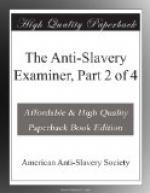The choir was composed chiefly of colored boys, who were placed on the right side of the organ, and about an equal number of colored girls on the left. In front of the organ were eight or ten white children. The music of this colored, or rather “amalgamated” choir, directed by a colored chorister, and accompanied by a colored organist, was in good taste.
In the evening, we accompanied a friend to the Wesleyan chapel, of which the Rev. James Cox is pastor. The minister invited us to a seat within the altar, where we could have a full view of the congregation. The chapel was crowded. Nearly twelve hundred persons were present. All sat promiscuously in respect of color. In one pew was a family of whites, next a family of colored persons, and behind that perhaps might be seen, side by side, the ebon hue of the negro, the mixed tint of the mulatto, and the unblended whiteness of the European. Thus they sat in crowded contact, seemingly unconscious that they were outraging good taste, violating natural laws, and “confounding distinctions of divine appointment!” In whatever direction we turned, there was the same commixture of colors. What to one of our own countrymen whose contempt for the oppressed has defended itself with the plea of prejudice against color, would have been a combination absolutely shocking, was to us a scene as gratifying as it was new.
On both sides, the gallery presented the same unconscious blending of colors. The choir was composed of a large number, mostly colored, of all ages. The front seats were filled by children of various ages—the rear, of adults, rising above these tiny choristers, and softening the shrillness of their notes by the deeper tones of mature age.
The style of the preaching which we heard on the different occasions above described, so far as it is any index to the intelligence of the several congregations, is certainly a high commendation. The language used, would not offend the taste of any congregation, however refined.
On the other hand, the fixed attention of the people showed that the truths delivered were understood and appreciated.
We observed, that in the last two services the subject of the present drought was particularly noticed in prayer.
The account here given is but a fair specimen of the solemnity and decorum of an Antigua sabbath.
VISIT TO MILLAR’S ESTATE.
Early in the week after our arrival, by the special invitation of the manager, we visited this estate. It is situated about four miles from the town of St. John’s.
The smooth MacAdamized road extending across the rolling plains and gently sloping hill sides, covered with waving cane, and interspersed with provision grounds, contributed with the fresh bracing air of the morning to make the drive pleasant and animating.




